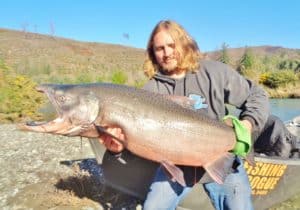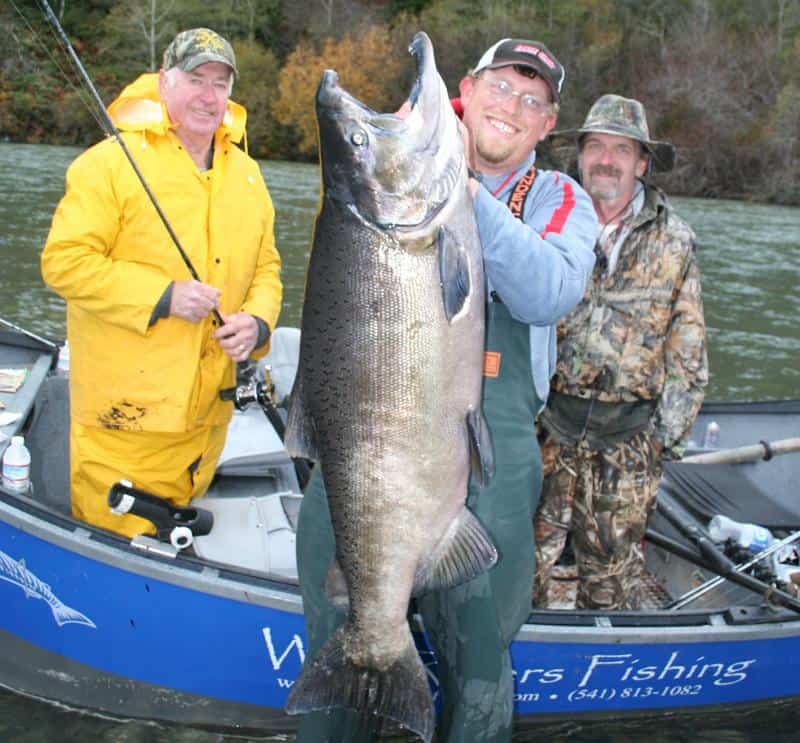With a relatively small human population and a large fall Chinook salmon population, southwestern Oregon is one of the best places in the Lower 48 to catch the largest of the Pacific salmon from August into November.
Below are the most productive bay and river systems in Oregon Department of Fish and Wildlife’s Southwest Zone, an area that stretches from the Umpqua River south to the California border.
This area also has several ports with ocean access to excellent summer and early fall fishing for chinook salmon at sea. Find those ports here.
Umpqua River and Winchester Bay
The bay near Reedsport often is one of the best producers of fall Chinook of any system in Oregon, often out-fishing the better known Rogue while frequently churning out 6,000, or 7,000, or even more large fall kings in a season.
(The Umpqua and Rogue, by the way, also have some of the Oregon coast’s best spring Chinook runs.)
The highest catch rates for the fall run are down in Winchester Bay, where salmon bite better with some salt water in their gills.
The town of Winchester Bay nearest the ocean is a hub for fishing activity, with marina services available. Reedsport and Gardiner farther up in the bay also serve as good access points to the bay fishery.
The river system itself is most productive in the lower reaches, including a long tidal zone that stretches nearly to Scottsburg
There also is a modest fishery in the Smith River, a tidal zone tributary near Gardiner and Reedsport.
Fall Chinook fishing is less productive in the North and South forks of the Umpqua. They come together to form the main river near Roseburg.
The Umpqua is an excellent choice for anglers wanting to get an early start to their fall salmon fishing but don’t want to go onto the open ocean to do it.
You’ll see catches in the bay begin in late July, with excellent results most likely into August and September. There will still be Chinook landed into October but the fishery will be tapering off here and better in some other places.
Coos Bay and Tributaries
Coos Bay is Oregon’s largest coastal bay and another of the state’s premier fall Chinook salmon fisheries, often producing close to as many fish as the Umpqua system to the north.
The bay itself is fished from between the jetties near Barview and Charleston up into the upper bay around North Bend and the city of Coos Bay.
Besides the main bay, there are fisheries in Isthmus Slough that parallels Highway 101 and also into the tributaries including the mainstem Coos River and into the South Fork Coos River. The Millicoma has a small fishery as well.
The main bay fishery gets going in August, but this bay is often at its best in September and should hold up nicely into early October.
The tributaries are likely to fish best after the first good fall rains from late September into October.
Coquille Bay and River
This is a smaller bay located at Bandon, a quaint coastal town popular with tourists. Despite its size, the bay and its river systems can produce 3,000 or 4,000 fall Chinook in a season.
Look for peak bay fishing to occur in September most years, although fish are generally available in decent numbers from late August well into October. Some years there is a fair fishery that continues into November.
The Coquille River and especially its forks provide a modest fall chinook fishery, although they are better known for some of this area’s best hatchery winter steelhead fishing.
Elk River

The Elk, which flows into the Pacific Ocean between Cape Blanco and Port Orchard, doesn’t have a bay fishery but is one of the best in-river places to catch fall Chinook on the southern Oregon coast.
Look for the Elk to produce 2,000 to 3,000 Chinook in a pretty good fall season, even without a bay fishery.
The Elk is also one of the later running Chinook fisheries in Oregon, usually peaking in November and often continuing into December, where it overlaps with the winter steelhead run on the south coast.
The Elk often doesn’t fish well until significant fall rains raise its level and unplug the sand bars that often form at the mouth in the summer months.
The river can rise and fall quickly, so time your trips between extreme precipitation for productive fishing.
The nearby Sixes River, on the north side of Cape Blanco, is often mentioned in the same breath.
Some years the catches in the Sixes are almost as robust as the Elk’s, but other years its wild-only Chinook fishery is significantly smaller.
More: Elk River Salmon and Steelhead Fishing.
Rogue River and Bay
The mighty Rogue, Southern Oregon’s best known salmon and steelhead river, is a good producer of fall Chinook salmon but isn’t necessarily its top producer during the late summer and early fall.
The Umpqua and Coos systems quite often produce a larger total catch.
The Rogue system is most productive in its lower sections for the fall run. The bay up to Elephant Rock gets off to an early start, often notching excellent catches in August and September.
The Middle Rogue, from Graves Creek up to the former Gold Ray Dam site (near Gold Hill) is a long stretch that produces reliable fall Chinook fishing close to the Grants Pass area within easy reach of Interstate 5.
Expect the best fishing in that middle stretch to happen in September.
The upper river above Gold Hill is less popularly fished for fall run salmon than spring Chinook or steelhead.
More: Rogue River Fishing for Salmon, Steelhead and Trout.
Chetco Bay and River
The Chetco system on the far southern coastline at Brookings in some years is the smallest overall producer of fall Chinook salmon we chose to spotlight among Southwest Oregon’s best fall Chinook fisheries, with total catches often 1,000 fish.
Yet we simply had to include it for one big reason: This smallish river often produces Oregon’s heaviest fall Chinook. We’re talking the potential of 60-plus pounders.
(That’s what you’re looking at in the top photo from several years back.)
The highest numbers of fish here typically aren’t landed until November, in large part because the free-flowing river upstream from the tidewater fishery often doesn’t open until about the first weekend of November.
Watch ODFW’s website for the exact opener. The tidewater typically is open throughout the fall season and can produce well into September and October, especially before major rains draw most fish upriver.
Also watch for a popular “bubble fishery” in the ocean at the mouth of the river to open before the river itself.
The Chetco isn’t Oregon’s most southerly fall Chinook fishery. That distinction belongs to the Winchuck River within spitting distance of Calfornia.
But the little Winchuck often produces under 200 fall Chinook during a season, so it’s not on par with the better fisheries not very much farther north.
More on this river: Chetco River Fishing.
Return to Oregon Salmon Fishing
Oregon Resources
ODFW Weekly Fishing Report
ODFW Trout Stocking Schedule
Oregon Fishing Regulations
National Weather Service

